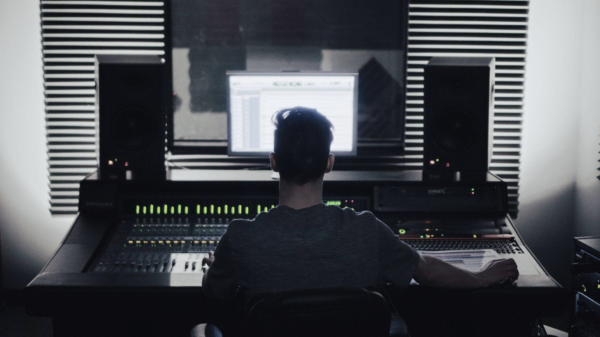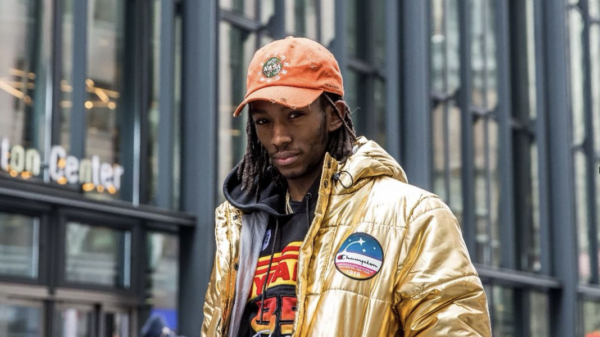Kelela has a music recommendation for you, if you’re looking for one. In a conversation just shy of an hour, the R&B and electronic music visionary pulls out all sorts of references. And while the names and titles of the tunes she’s thinking of may be fuzzy, she can describe the feeling of a song with a marksman’s clarity.
“It was an arrangement of that Hole song, you know the band Hole? … You have to go look,” Kelela asks over Zoom before pulling out her phone to search for a clip of Amel Larrieux rearranging the alt-rock band’s “Celebrity Skin” (though it turns out to be such a deep cut, it can’t be immediately located). “She slowed the song down and did a heavy bass moment. It was, like, my favorite thing.”
The jukebox that lives in Kelela’s head, full of Bill Evans deep cuts, Biggie Smalls classic hip-hop tapes, and newer tracks by Shygirl and Fousheé, comes from conversations with like-minded musicians, such as her music director, Daniel Aged; seeds planted from her father’s listening habits; and from her own experiences as an audience member and musician.
Over the past decade, she’s built a catalog that feels like a multiverse of electro-heartbreak emphasized by her ability to renew her existing songs with new arrangements. “Sometimes the thing that I was saying in the club, when you slow it down and I sing it like I’m whispering in your ear… I even feel different feelings,” she says. “That’s kind of what I hope for when I am rearranging any song, but especially my own.” Through 2023’s Raven, 2017’s Take Me Apart, 2015’s Hallucinogen, all the way back to her 2013 mixtape debut, Cut 4 Me — and the remix albums in between — Kelela has continuously called on the musicians surrounding her to help determine where she goes next.
Right now, that’s In the Blue Light, a live jazz album and accompanying mini-documentary recorded during her sold-out residency at New York’s Blue Note club last spring. For Kelela, playing the storied venue brought back memories of driving six hours from her home in D.C., on a school night, to witness Larrieux there circa 2003.
Editor’s picks
“This was pre-iPhone,” Kelela tells Rolling Stone. “I used to be really big on the MiniDisc. I would hold my MiniDisc recorder underneath the table for the entire show and just record her improvisations.” Those illicit recordings served as lesson plans for Kelela as she practiced crafting her own sound, playing back the show while driving back the same night in her mom’s champagne-colored ‘97 Toyota Corolla. “It was a lot to do that, but it was worth it,” she says.
Tomorrow’s artists can save on a little gas money by streaming Kelela’s live album, which features 12 selections that Kelela and her band rehearsed for four days, or the nearly 20-minute film that documents the process. “The track list was kind of hard to narrow down, but it’s a combination of my songs that I think people would really like and need to hear, and things that just personally mean a lot to me,” she says. “And [songs] I kind of always wanted my audience to know about” — like covers of legendary jazz singer Betty Carter and folk-music icon Joni Mitchell.
As a second-generation Ethiopian American, Kelela didn’t grow up listening to Mitchell, but became familiar with her music in her twenties, being drawn specifically to Mitchell’s jazz era. “I’ve always been in love with music that kind of sits on a fault line, or feels like it’s excavating new space,” she says. On In the Blue Light, that means a cover of 1976’s “Furry Sings the Blues,” where Mitchell recalled observing the Black blues musician Furry Lewis playing on Memphis’ famed Beale Street, which appeared dilapidated at the time.
Mitchell’s song appeared on her album Hejira, which got rave reviews and became one of her highest-regarded works, but Lewis was vocal about feeling used for source material. “I think he felt exploited,” Kelela says. “And, you know, this lives alongside her long history with Blackface … I didn’t know about this stuff until after I’d fallen in love with her music, irritatingly.”
Related Content
By covering “Furry Sings the Blues,” Kelela wanted to shed light on the race relations within jazz, while still acknowledging that Mitchell “ate with the pen” when it came to her extraordinary songwriting. ”That is kind of the story of American music,” she says. “Black people make something and then white people extract it and get the credit for it.”
In the Blue Light centers the Black jazz musicians that set the foundation for Kelela’s own lyricism and music. “I have two Betty Carter songs on there because I’m obsessed with Betty Carter,” she says. With the bass-thumping “30 Years” and the slow, undulating snare brushes of “Love Notes,” she pays homage to the jazz singer’s vulnerability.
Even the structure of this album was inspired by jazz history. “There’s a Sarah Vaughan album called At Mister Kelly’s that I kind of used as a reference,” she says. “Like the introduction of the record, the person in the house announces that she’s about to come on … You can hear the plates clinking, and you really feel like you’re there.” Similarly, on In the Blue Light, you can can hear Kelela’s friend say “period” as she prepares to sing the title song from Raven. “It just feels very live in this way that I’ve always thought was so sweet,” she adds of Vaughan’s 1957 recording.
Kelela also makes a point of stopping her own set for “church announcements” to bring attention to the devastation in Palestine and to call for reparations, repeating the latter statement for emphasis. “I think it’s very important to center the experience of and the legacy of the people who have made this music,” she says. “Reparations now is something that I feel like is a very ignored and devalued, legitimate-ass claim.”
With this project done, Kelela says she’s back in “album mode” for an upcoming project that she’s ”really excited” about and promises won’t be far away. She says the record will be “going back to something that I kind of started with,” musically. “If I talk about it, it’s gonna give it away,” she adds. “I’m gonna wait on it, but I will say that I am working on it.”
Kelela mentions some newer artists she’s been listening to, like Fousheé (“She’s so good. She’s so good at music”), PinkPantheress, and Shygirl — all of whom she calls her “baby sisses.”
“The line between what they’re doing and what I’m doing is a really sweet thing,” she says. “The way that they have expressed the influence has really touched me. And then collaborating is just another sweet layer on top of that.”




























